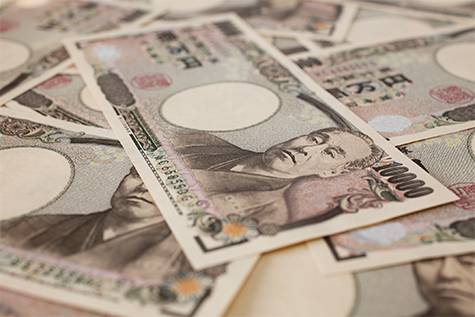The dollar fell in European trade on Thursday against a basket of major rivals, moving in a negative zone for the second straight session amid full pricing for Federal Reserve rate cuts in September and November.
Now investors await crucial US GDP growth data later today to reassess the trajectory ahead for monetary policies.
The dollar is also pressured by the unwinding of the yen carry-trades, through which investors borrowed low-yield currencies such as yen, to buy high-yield currencies such as the dollar.
However, as the yen's prospects changed favorably and traders unwinded the carry trades, they bought massive amounts of yen and further boosted its standing.
Price
- The dollar index fell 0.3% to 104.08, with a session-high at 104.40.
- The index closed down 0.15% on Wednesday, the second loss in three days away from a two-week high at 104.56, under pressure from disappointing US industrial data.
Sudden Contraction
Earlier US data showed a sudden contraction in the manufacturing PMI from 51.6 in June to 49.5 in July, diving below the 50 barrier that separates growth from shrinkage.
US Rates
- Following the worrisome data, the odds of a Fed 0.25% rate cut in September rose to 100% according to the Fedwatch tool, and the odds of such a cut in November rose to 100% as well.
US Growth Data
Later today, crucial US GDP Growth data will be released, expected to show an expansion of 2.0% in the second quarter, up from 1.4% in the first.
US unemployment claims are also expected to have fallen to 237 thousand in the week ending July 20 from 243 thousand in the previous reading.
Yen’s Spike
A spike in yen’s value against an array of major rivals upended the markets, as investors scurried to unwind the carry trades ahead of Bank of Japan’s meeting next week.
Yen’s movements contributed to the chaos already in place due to the heavy selloff in tech shares, which in combination served to drag global markets downwards.
Investors are now rushing to reassess their long-term strategies and reduce risks amid the volatile conditions.
Gold prices fell in European trade on Thursday, plumbing two-week lows and giving up the psychological barrier of $2400, with prices upending expectations due to the yen’s surge.
Yen’s stunning gains sowed chaos in the financial markets, and forced a heavy selloff in many assets including gold and bitcoin as investors reassess their financial bets.
Most analysts expected gold prices to be stable, especially after weak US manufacturing data boosted the odds of Fed rate cuts in September and November.
Investors now await important US GDP data later today to gauge the likely path ahead for US policies.
Prices
Gold prices fell 1.3% today to $2365 an ounce, the lowest since July 10, with a session-high at $2401.
On Wednesday, gold prices lost 0.5%, resuming losses after a short hiatus, as the yen rallied.
Yen’s Rally
Yen spiked against major rivals on Thursday, hitting 2-⅕ month highs against the dollar, as investors unwind carry-trades, through which they heavily borrowed low-yield currencies such as yen to buy high-yield currencies such as the dollar.
As expectations shift and investors expect a Bank of Japan rate hike this year, investors have rapidly backed off their carry trades, and bought a lot of yen, in turn adding to the momentum.
Bullis Outlook
Gold remains with a positive outlook, with some analysts expecting a surge to $2500, especially as the Fed prepares to ease policies and cut rates.
Lower interest rates underpin non-yielding assets such as gold as they become attractive again to investors.
Sudden Contraction
Earlier US data showed the manufacturing PMI down to 49.5 in July, diving below the 50 barrier that separates growth from contraction, while analysts expected an increase to 51.7.
US Rates
Following the data, and according to the Fedwatch tool, the odds of Federal Reserve rate cuts in both September and November rose to 100%.
The SPDR
Gold holdings at the SPDR Gold Trust remained flat yesterday at 841.74 tonnes, the highest in a week.
Gold prices are moving contrary to expectations, influenced by the substantial rise in the Japanese yen. This unexpected movement in the currency market is causing significant shifts in various asset classes, including gold.
- Precious metal drops below $2,400 per ounce
- Deepest losses in two weeks for gold
- Market awaits US economic growth data
Gold prices in the European market on Thursday extended losses for the second consecutive day, hitting the lowest level in two weeks after abandoning trading above the psychological barrier of $2,400. Prices are currently moving contrary to most bullish expectations due to the sharp rise in the Japanese yen.
The dramatic rise in the yen is turning global markets upside down, triggering a widespread sell-off in financial assets from global stocks to gold and Bitcoin as investors reassess their leveraged bets.
Most expectations were stable around the rise in gold prices, especially after data on the contraction of industrial activity in the United States led to a full pricing of the likelihood of US interest rate cuts in September and November.
To reassess and ensure the strength of these probabilities, investors are waiting later today for the release of US economic growth data for the second quarter of this year.
Price Overview
- Gold prices today: Gold prices fell by 1.3% to $2,365.94, the lowest since July 10, from an opening level of $2,397.89, with the highest level recorded at $2,401.27.
- On Wednesday, gold prices lost 0.5%, resuming losses that had paused the previous day for the first time in five days, due to the rise of the Japanese yen.
Yen's Impact on Markets
The Japanese yen rose widely on Thursday against a basket of major and minor currencies, reaching the highest level in two and a half months against the US dollar, due to accelerated unwinding of "carry trade" positions before the Bank of Japan meeting next week, and full pricing of US interest rate cut expectations in September.
The yen's surge has already turned markets upside down, triggering a widespread sell-off in most global stock markets, led by technology stocks, as well as declines in precious metals, led by gold and cryptocurrencies like Bitcoin.
Investors are reassessing their leveraged bets, leading to changes in their investment strategies and attempting to minimize the growing risks in the volatile market environment.
The Japanese yen surges due to carry trade unwinding
Bullish Expectations
Most expectations are currently stable around the rise in gold prices in the short and medium term, with a significant possibility of reaching new record levels near $2,500 per ounce, especially with the Federal Reserve getting closer to starting monetary easing and cutting interest rates.
As we know, global interest rate cuts, led by US interest rates, reduce the opportunity cost of holding non-yielding gold bullion.
Unexpected Industrial Contraction
Data on Wednesday in the United States showed an unexpected contraction in the manufacturing sector, with the preliminary purchasing managers' index registering 49.5 points in July (50 is the dividing line between growth and contraction), contrary to expectations of growth at 51.7 from 51.6 in June.
US Interest Rates
- Following these data, according to the "FedWatch" tool by CME Group, the pricing of futures contracts for US interest rate cut probabilities by 25 basis points in September rose from 96% to 100%, and the probability of a cut in November rose from 98% to 100%.
- To reassess these probabilities, investors are waiting later today for the release of US economic growth data for the second quarter of this year.
Gold Performance Expectations
- Jim Wyckoff, senior analyst at Kitco Metals, said: "The weaker US dollar index and lower US stock indexes are supporting buying interest for both gold and silver."
- Chris Gaffney, head of global markets at EverBank, said: "The main thing helping gold right now is market expectations that the Federal Reserve may actually decide to cut rates as early as September."
- Gaffney added: "The reduction in India’s import taxes on gold and silver also helps in increasing prices as it boosts actual demand in the world's second-largest consumer of metals."
SPDR Gold Trust
Holdings of gold with SPDR Gold Trust, the largest global gold-backed exchange-traded fund, remained unchanged yesterday, with the total remaining at 841.74 metric tons, the highest level in a week.
Invest in GoldThe yen surged over 1% against the US dollar, breaking the critical 155 yen per dollar level and surpassing the 100-day moving average for the first time since mid-March. Analysts link this movement to the unwinding of global carry trades, where investors borrow in low-yielding currencies like the yen to invest in higher-yielding ones such as the Mexican peso or the Australian and New Zealand dollars.
This unexpected yen strength is disrupting global markets, boosting the yuan and impacting assets from Japanese stocks to gold and Bitcoin as investors reassess their leveraged positions.
On Thursday, the yen climbed to its highest level in over two months against the dollar, driven by growing expectations that the interest rate gap between Japan and the US will narrow. This stronger yen is adversely affecting Japanese exporters, causing the Nikkei 225 index to enter a technical correction. Meanwhile, the yuan hit its highest level in more than a month, and currencies like the Australian dollar suffered as carry trades became less attractive.
Global Market Impact
The yen’s appreciation is causing significant shifts across various asset classes. Investors who previously engaged in carry trades by borrowing yen to invest in higher-yielding assets are now reversing these positions, leading to notable market movements. Japanese equities are under pressure due to the stronger yen reducing export competitiveness, pushing the Nikkei 225 index into correction territory.
The ripple effect is also visible in other Asian currencies, especially the Chinese yuan, which has reached its highest level in over a month. Commodities like gold and Bitcoin are also experiencing pressure as leveraged bets are unwound. Gold, typically considered a safe-haven asset, is being sold off to cover losses elsewhere, while Bitcoin’s volatility is heightened by the unwinding of risk-on trades.
Interest Rate Outlook
Market participants increasingly expect the Bank of Japan to adjust its ultra-loose monetary policy sooner than previously anticipated. Speculation is mounting that the interest rate gap between the US and Japan will narrow, especially if the Federal Reserve pauses or reverses its rate hike strategy. This expectation is bolstering the yen as investors foresee a more balanced interest rate environment.
A narrowing interest rate differential reduces the attractiveness of carry trades, where investors borrow in low-interest currencies to invest in higher-yielding assets. As this gap narrows, the appeal of these trades diminishes, prompting a broad unwinding of positions that previously favored higher-yielding currencies and assets.
Investor Perspectives
The rapid appreciation of the yen underscores the interconnected nature of global financial markets and the potential for swift changes in market sentiment. Investors must remain vigilant and adaptable, particularly those involved in carry trades or holding leveraged positions in risk-sensitive assets.
For Japanese exporters, a stronger yen presents challenges by making their products more expensive abroad, potentially squeezing profit margins. Conversely, importers could benefit from lower costs for goods purchased from other countries. The broader impact on Japan’s economy will depend on the balance between these effects and the Bank of Japan’s response to the changing monetary landscape.
As the global financial community closely monitors these developments, the upcoming weeks will be crucial in determining whether the yen’s surge is a temporary correction or the start of a more sustained trend. Investors are encouraged to watch economic indicators and central bank communications for further insights on interest rate directions and potential currency market volatility.
Invest in YenDisclaimer: The copyright of this article belongs to the original author. Reposting this article is solely for the purpose of information dissemination and does not constitute any investment advice. If there is any infringement, please contact us immediately. We will make corrections or deletions as necessary. Thank you.







